Nutrisense is a continuous glucose monitoring (CGM) platform that consists of a mobile app, a third-party CGM sensor (the Abbott FreeStyle) and a personalized coaching offering to help you achieve your individual wellness goals, such as improving your metabolic health, losing weight, lowering your blood sugar levels and improving your athletic performance.
In the United States, CGMs require a prescription, and they can be difficult to obtain. One major benefit of Nutrisense is that the company will obtain a prescription on your behalf and ship the CGM hardware to you free of charge (assuming you’re willing to sign up for a monthly membership).
I’ve been using Nutrisense on and off since September 2022. In this article, I’ll share three surprising things I’ve learned by continuously monitoring my blood glucose levels, and I’ll explain how you can use Nutrisense to improve your metabolic fitness and fine-tune your diet.
Before we get into the nitty-gritty, it’s worth pointing out that my goal with using Nutrisense hasn’t been to lose weight or improve my metabolic health. Instead, I’ve been using Nutrisense to gain more insights into how my body responds to certain lifestyle behaviors, such as carb timing, intense exercise, sauna bathing and stress. Despite having a solid understanding of my body’s blood sugar response from prior tests, I was surprised by several of the findings I discovered while using Nutrisense.
Nutrisense Review

Pros
- Has an advanced yet easy-to-use mobile app that offers native integration with third-party platforms like Apple Health.
- Offers 30 days of in-app complementary nutrition coaching.
- Your health insurance may pay for video coaching calls.
- The monthly fee is HSA/FSA compatible.
Cons
- Scanning of the CGM sensor can be finicky, based on my testing.
- Monthly membership fees range from $225 to $399, depending on how long you commit.
- Does not have native support for Dexcom CGM sensors, although a workaround via Apple Health integration is available.
The Nutrisense Onboarding Process
Getting started with Nutrisense requires filling out a short questionnaire and providing some personal information, including any current medical conditions or prescription drugs you might be taking.
Assuming your answers don’t make you ineligible for the Nutrisense program, you can select from one of the monthly membership options (as well as any add-ons you’d like to include) and provide your shipping and payment information. (If you’re younger than 18 years old, are pregnant, are undergoing cancer treatment, or are taking exogenous insulin, you can’t sign up.)
You’ll receive your first set of CGM sensors within three to six business days. While waiting for your sensors to arrive, you can download the free Nutrisense app and start exploring it. You can even start chatting with your assigned nutrition coach to discuss your goals and make a plan for how to accomplish them.
Since I have my diet dialed in reasonably well, I haven’t needed any nutrition coaching. But as part of my testing, I interacted with two of the coaches and found them to be incredibly responsive and helpful.
Once you receive your sensors, you can activate the first one via the app and wait an hour for the hardware to initialize. After the brief waiting period, you can start scanning the sensor using an NFC-enabled smartphone.
Nutrisense App
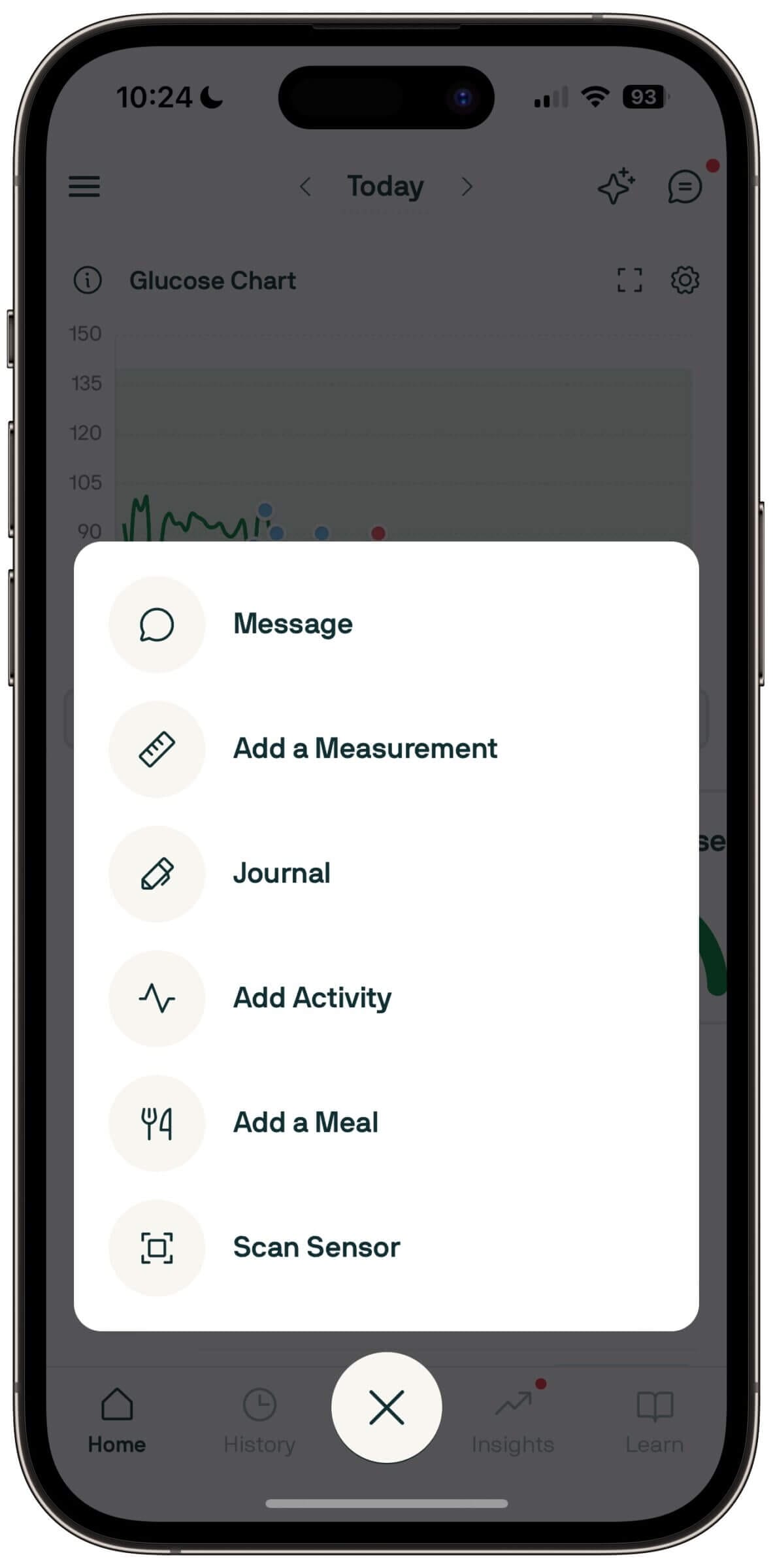
The thing I like most about Nutrisense is its mobile app, which is incredibly easy to use but massively powerful at the same time.
I’ve been using the Nutrisense app for the following tasks, including:
- Scanning my CGM sensor every couple of hours.
- Logging meals (with pictures).
- Checking my daily glucose score.
- Assessing how carb-laden meals, workouts, sauna bathing and similar activities impact my blood sugar levels.
One detail I’ve come to appreciate is the app’s ability to automatically detect food in the pictures you take or upload when you log a meal. That makes detailed meal logging, including counting your caloric and macronutrient intake, very simple.
I’m not a huge proponent of counting macros (as discussed in Episode 34 of my Primal Shift podcast). However, having the app populate the meal description is helpful when searching for previously logged meals.
The app makes it easy to accomplish those tasks in just a few clicks. For more advanced users, the app also offers the following features:
- Detailed insights, including time in range, min, max and average glucose readings, sleep and morning averages.
- Access to a full history of past readings, logged meals, and activities you can filter to find exactly what you’re looking for.
- A journal feature to track your mood, energy, focus, stress and appetite.
- Access to Nora, a personal AI assistant who can answer questions and direct you to additional resources.
- A built-in chat function to talk to customer support and your nutrition coach.
- Additional resources (blog posts and videos) to learn more about mastering blood sugar levels and nutrition.
- The ability to manually calibrate your CGM sensor (using a finger prick test).
- An option to conduct experiments that allow you to compare how your body responds to different meals or ingredients.
Overall, I found the Nutrisense app easy to use and navigate, with one exception.
Unlike other CGM platforms, Nutrisense allows you to scan your FreeStyle Libre sensor directly from within the app, so you don’t have to download and use the native Freestyle app.
While that’s a huge convenience factor, scanning the sensor using the Nutrisense app was more finicky than using the native app with my iPhone 14 Pro running a beta version of iOS 17. In other words, I had to align the NFC sensor of my phone perfectly with the CGM sensor.
While that might not sound like a big deal, it can be challenging if your sensor is located on the back of your upper arm where you cannot see it (that’s where I prefer wearing mine, so as to reduce the risk of the sensor making contact with exercise equipment).
The FreeStyle app appears to be much more forgiving, because it doesn’t complete the scan until it receives good data. In contrast, the Nutrisense app accepts the scan even if it didn’t receive good data. As a result, I ran into many scanning errors (see the image below) that required several clicks to dismiss and try again.
For a while, I even thought I was dealing with a faulty sensor because of the frequent errors I received. But then I realized that I had to be more precise.

The good news is that Nutrisense’s support team was excellent in helping me figure out what was going on. Still, I hope their software engineers will improve the app to make scanning more reliable.
CGM Sensor Hardware
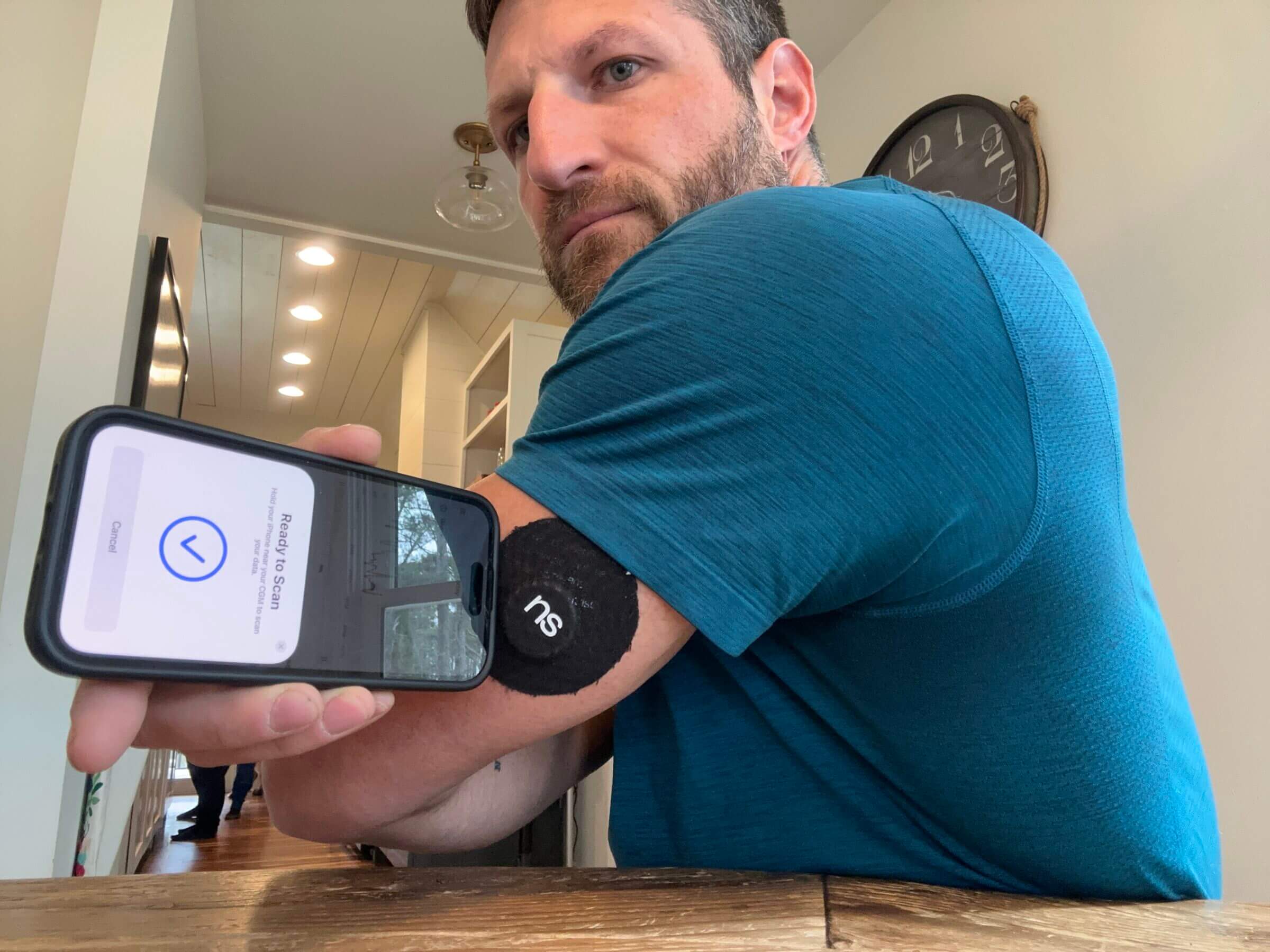
Despite what you may have heard, Nutrisense doesn’t make continuous glucose monitor hardware. Instead, the company offers a mobile app that integrates with third-party CGM hardware, specifically the FreeStyle Libre 1, 2 and 3. The latter offers continuous data streaming via Bluetooth, so you don’t need to scan it every eight hours (that’s how much data the Freestyle Libre 1 and 2 can store at a time).
What’s important to understand is that while the app supports all three generations of FreeStyle Libre sensors, when you sign up for a Nutrisense membership, you get the FreeStyle Libre 1. However, Nutrisense now offers an option to bring your own CGM instead of buying it from them.
That’s a welcome feature for those who prefer using the FreeStyle Libre 2 or 3.
If you want to learn more about the two primary CGM sensors on the market, check out my article comparing the Dexcom and the FreeStyle Libre.
While there are pros and cons to both types of sensors, what I like about the FreeStyle Libre is that each sensor lasts two weeks before you have to replace it, as opposed to 10 days with the Dexcom. The Libre is also less expensive.
Nutrisense Coaching
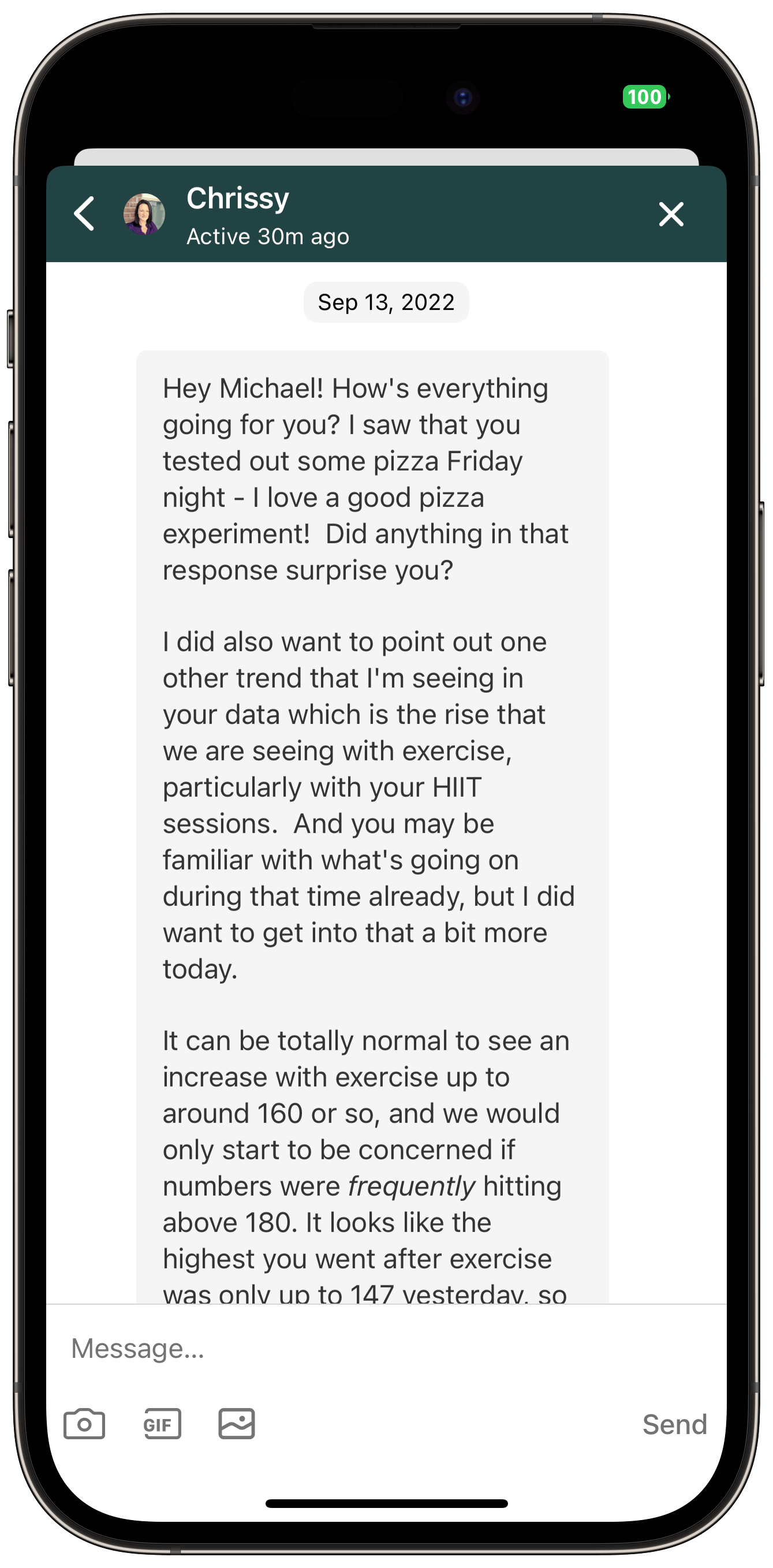
Arguably, one of the most helpful features of Nutrisense is the personalized coaching programs that are available to help you make sense of your glucose readings and give you dietary advice.
You get complimentary access to nutrition coaching during the first 30 days of your membership. After that, you can sign up for a monthly nutrition coaching program, a one-time video consultation, a dietary supplement review, or a seven-day personalized meal plan.
I follow an animal-based dietary framework that I’ve been fine-tuning for the past few years, and I feel like I have everything dialed in well. As a result, I haven’t participated in any of the coaching programs.
However, I know that Nutrisense has a variety of nutritionists and coaches on staff, so you’ll likely find one you like and who matches your dietary preferences.
Nutrisense Membership Pricing
Nutrisense’s pricing is relatively straightforward and consists of a monthly membership fee that gives you access to the mobile app and 30 days of complementary nutrition coaching.
What’s new is that Nutrisense now allows you to bring your own CGM sensor, which is a feature that wasn’t available when I first signed up in 2022. The table below offers an overview of the different membership options you can choose from.
| Membership | Fee |
|---|---|
| Basic membership | $199 per year. Bring your own CGM or purchase a pair of sensors from Nutrisense for $250. |
| Month-to-month | $399 per month. |
| 3 month commitment | $299 per month. |
| 6 month commitment | $250 per month. |
| 12 month commitment | $225 per month. |
Based on the pricing table above, one of the most attractive plans Nutrisense offers is the annual membership that allows you to bring your own CGM sensor or purchase a pair from Nutrisense.
However, remember that the relatively inexpensive annual membership doesn’t include the 30 days of complimentary nutrition coaching. If that’s essential for you, the month-to-month membership is your next best bet.
Regardless of what option you choose, make sure to use code KUMMER25 to get $25 off your first month.
It’s important to mention that the only way to sign up for the basic membership is from within the Nutrisense mobile app. If you go to nutrisense.io, you’ll only see the monthly membership options.
Also, all plans renew automatically until canceled.
3 Things I Learned From Using Nutrisense
Despite having spent a lot of time and energy optimizing my performance and metabolic health over the past few years, I discovered a few things that surprised me while using Nutrisense.
1. How My Body Responds to Heat Stress

I recently conducted experiments to gain more insights into how my cardiovascular system responds to heat stress. Specifically, I wanted to determine whether an infrared sauna or a traditional sauna induces more cardiovascular stress (and thus, offers more health benefits).
To measure the impact of heat stress on my body, I used a Frontier X2 heart rate monitor to record my heart rate, heart rate variability, respiratory rate and cardiovascular strain. I also wore the FreeStyle Libre 1 CGM, which I got through my Nutrisense membership, to see if heat stress would impact my blood glucose readings.
Surprisingly, I noticed significant blood glucose spikes of up to 64 mg/dL, likely stemming from my body’s natural stress response. In other words, my sympathetic nervous system ensured I had enough energy to run or fight. Additionally, changes in blood flow from vasodilation might have also affected the distribution and utilization of glucose in the body, thus leading to elevated levels.
I’ve noticed similar glucose spikes during CrossFit workouts, and it’s worth mentioning that they’re not a reason for concern.
Don’t get me wrong, chronically elevated blood glucose levels stemming from (chronic) stress can be an issue and lead to insulin resistance. But the occasional exercise or sauna-induced spike isn’t a problem.
And if you’re wondering, my high-humidity Finnish sauna caused a bigger spike than my infrared sauna!
2. Consuming Sourdough Bread Leads to a Better Blood Sugar Response Than Regular Wheat Dough
In my article discussing why regular pizza is unhealthy, I included the screenshot I took using the FreeStyle Libre app several years ago that showed my blood sugar response to regular (wheat dough) pizza.
Here it is again:

As you can see, I finished said pizza around 7 p.m., and my blood sugar spiked by 50 points and didn’t return to normal levels until 4 a.m. In other words, the wheat flour in the dough of the pizza I ate kept my blood sugar levels elevated for eight hours.
I recently repeated the pizza experiment using homemade double-fermented sourdough pizza, which led to a dramatically different (albeit still not ideal) blood sugar response. Specifically, my blood sugar levels rose by about 32 points and normalized four hours later (as shown below).
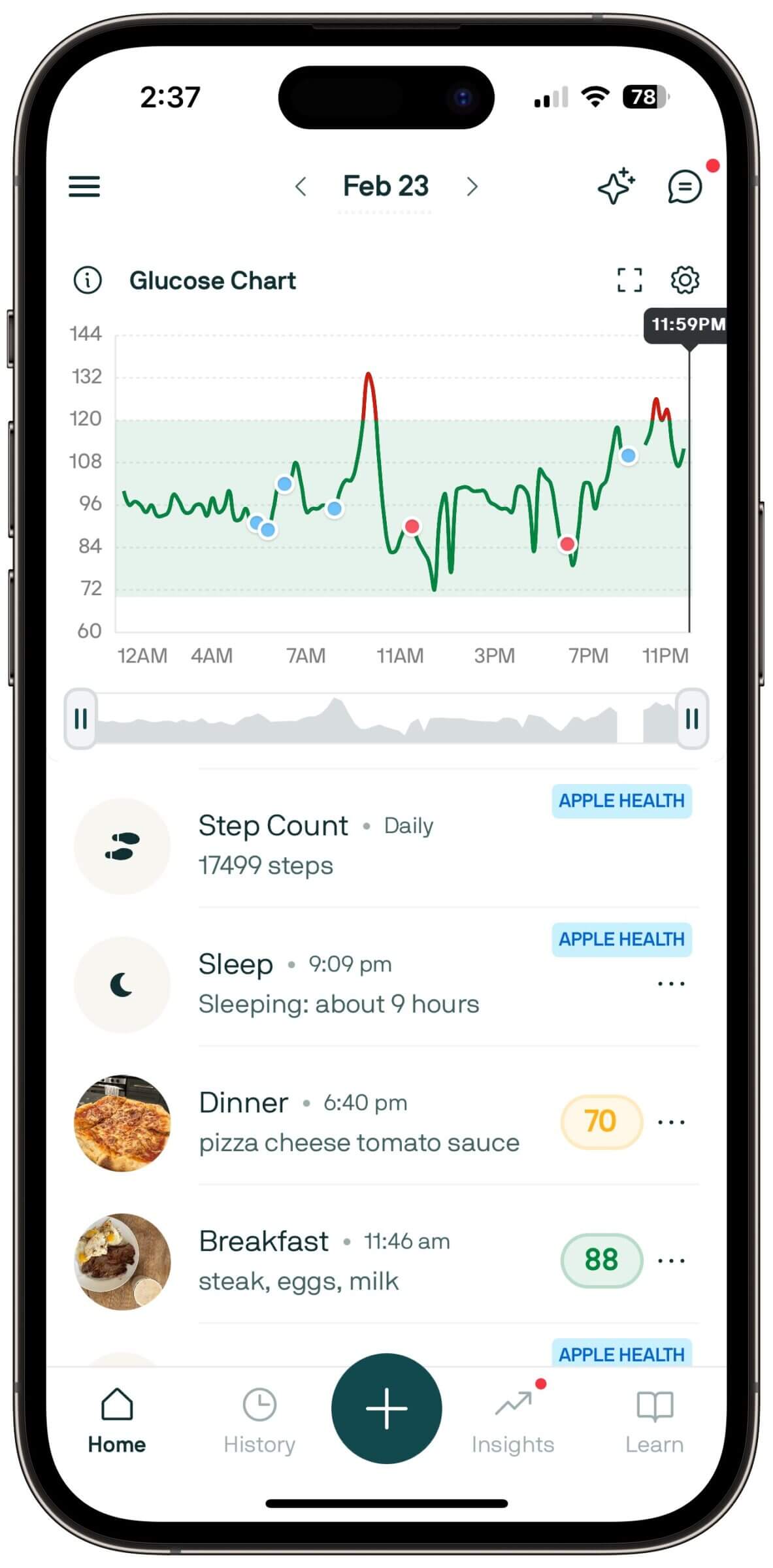
The reason for the better (but not ideal) blood sugar response is likely due to the lower glycemic index of fermented wheat flour, the lower pH of sourdough that slows down gastric emptying, and the change in starch structure caused by the microbial activity in sourdough.
Unfortunately, that doesn’t mean you should be having sourdough pizza every night, but enjoying homemade pizza with a sourdough crust every so often is better than traditional alternatives.
3. How Carb Timing Can Mitigate Blood Sugar Spikes

Ever since I transitioned to an animal-based diet and began eating more raw honey and sweet fruits, I’ve been consuming significantly more carbs than during my three-year keto stint.
These days, I consume between 50 to 150 grams of carbs per day, and I was curious to find out how much my carb intake would influence my blood glucose readings.
It’s worth pointing out that I consume most of my carbs during the second half of the day.
The other day, I had one of my favorite dishes for a relatively late breakfast. It was already 2 p.m. when I sat down with a charcuterie board of avocado, uncured salami, raw cheese, pan-fried plantains and sardines.
I ate all the protein first and then enjoyed the plantains and cheese with spoonfuls of raw honey (from our bees). I must have consumed nearly 150 grams of carbs (mainly from the honey), yet my blood sugar increased by only 11 points to 91 mg/dL. The 101 grams of fat and 54 grams of protein I front-loaded likely helped slow the raw honey’s absorption.
To my surprise, I noticed that virtually all of the meals I logged (except for pizza) led to a relatively high “Meal Score” (a metric that takes glucose peak, exposure, stability and recovery after a meal into account).
The lesson I learned was that post-loading carbs when consuming high-protein or high-fat meals helps blunt your blood sugar response.
Who Should Use Nutrisense?
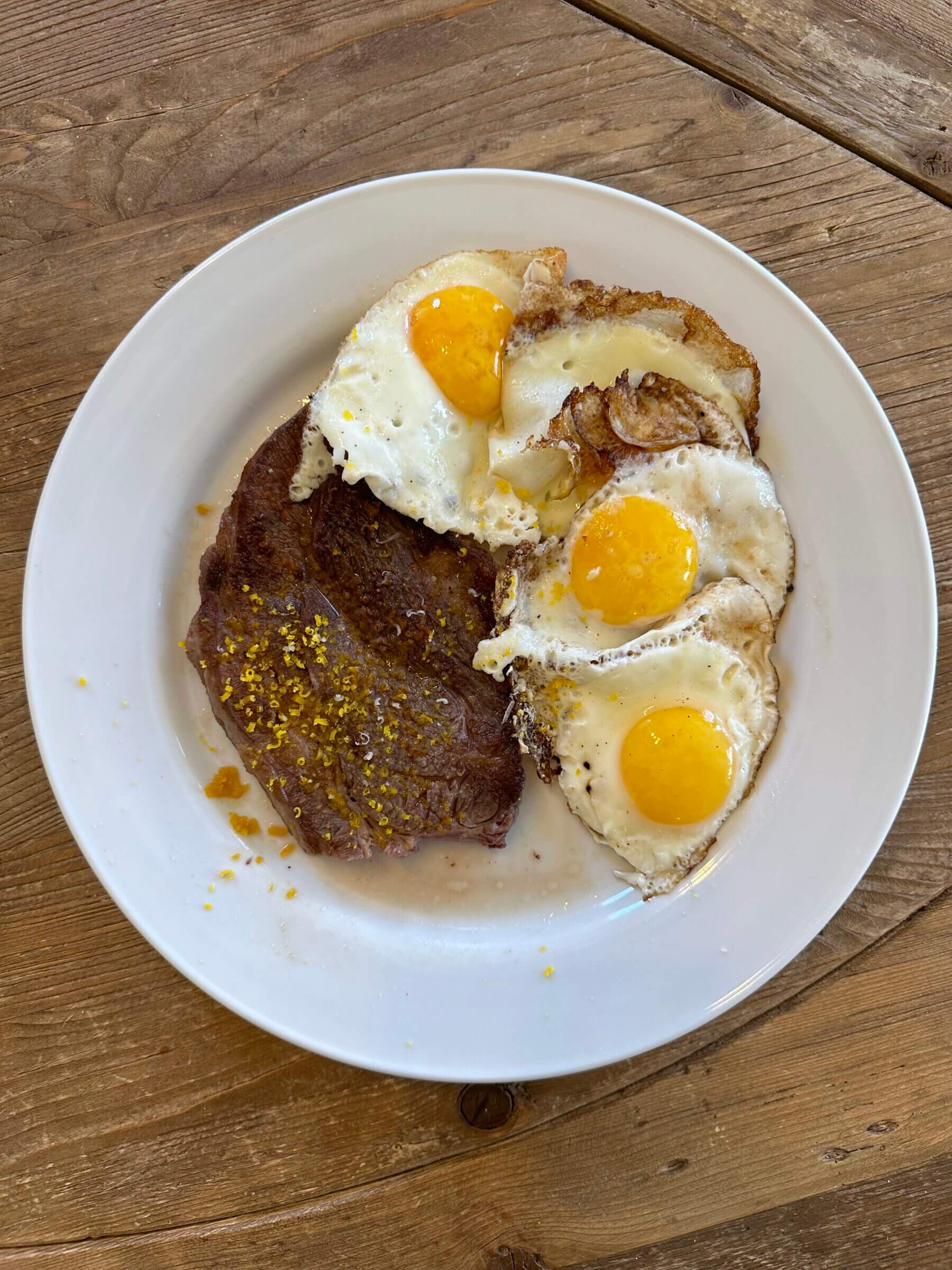
My view is that most people can benefit from continuous glucose monitoring because it offers invaluable insights into how your body responds to food and various stressors, including chronic and hormetic stressors (e.g., exercise or sauna bathing).
While a certain amount of glucose circulating in your bloodstream is necessary to function optimally, problems arise when glucose levels stay chronically elevated, or when they experience a high degree of variability.
CGM platforms like Nutrisense can help you understand how your blood sugar levels behave over time, as well as what factors might cause dramatic and prolonged spikes.
When I interviewed Erin and Laura from the Primal Health Coach Institute for my podcast, Erin told me that she was diagnosed with pre-diabetes (despite following a low-carb diet) because stress kept her blood glucose chronically elevated. The latter caused her cells to become less sensitive to the signals of insulin, one of the root causes of most chronic ailments.
Here are some other examples of who can benefit from using Nutrisense:
- You’ve been unsuccessfully trying to lose weight or lower your body fat.
- You live or work in a high-stress environment (e.g., stay-at-home moms, executives, medical professionals, law enforcement officers).
- You experience fluctuating energy levels throughout the day.
- You feel tired after meals.
- Skipping a meal makes you irritated.
- You’re looking to improve or optimize your physical or mental performance.
If one or more of these statements applies to you, consider using Nutrisense to gain more insights into your metabolism.
You can also learn more about CGMs in general in my article “How Continuous Glucose Monitors Can Improve Your Health and Fitness.”
Frequently Asked Questions
While your insurance won’t pay for the Nutrisense membership, you can likely use your insurance to pay for the nutrition video coaching Nutrisense offers. According to Nutrisense, “most members are eligible for insurance coverage of this service for $0 out-of-pocket.”
Levels Health and Nutrisense are two leading continuous glucose monitoring (CGM) programs that offer unique features and benefits for tracking and understanding blood glucose levels in relation to lifestyle factors.
Levels Health stands out for its simplicity and ease of use, integrating seamlessly with Apple Health to import exercise and sleep data. It focuses on providing a user-friendly interface with basic analytics, but lacks advanced features such as in-app scanning with the FreeStyle Libre sensor and detailed nutrition coaching.
On the other hand, Nutrisense offers a more comprehensive approach with advanced analytics, in-app scanning for the FreeStyle Libre sensor (eliminating the need for a separate app), and integration with a wider range of health platforms, including Apple Health, Biosense, Garmin, Oura, Fitbit and Keto-Mojo.
Nutrisense also provides complimentary 30-day nutrition coaching, supporting users in making informed dietary decisions based on their glucose data. This program is ideal for those who prefer a more detailed analysis of their glucose levels and a more integrated health management experience.
To learn more, check out my detailed Levels Health vs. Nutrisense comparison article.
Nutrisense allows you to bring your own CGM sensor and use it with its mobile app. To do so, you can download the Nutrisense app and sign up for an annual plan that costs $199. Remember that the Nutrisense app natively supports the FreeStyle Libre 1, 2 or 3 sensors. Support for Dexcom sensors is limited via its integration with Apple Health.
Nutrisense Review: Summary and Final Verdict
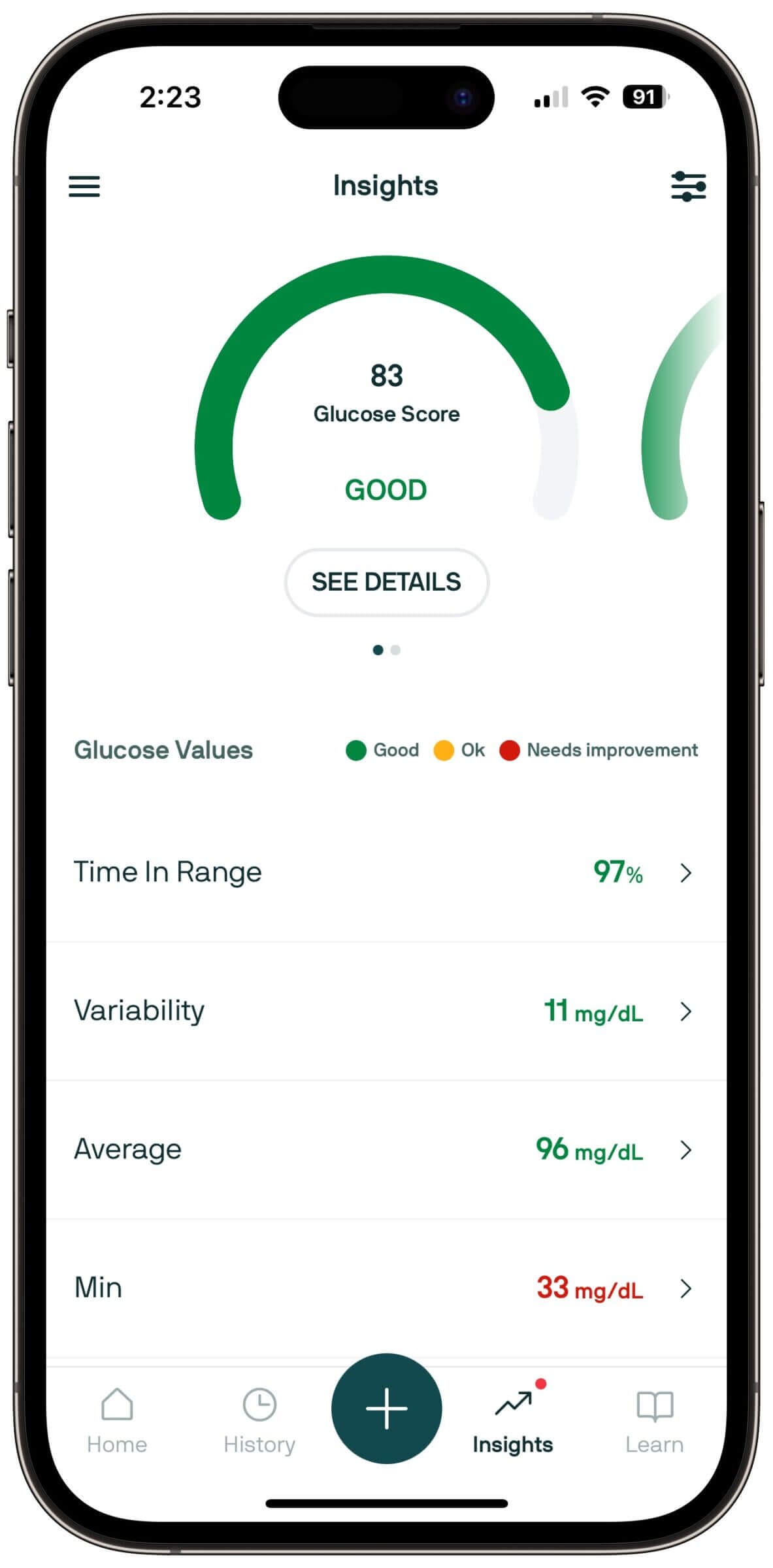
Insulin resistance is one of the key factors in the development of most metabolic diseases, including Alzheimer’s, dementia, Type 2 diabetes, cancer, cardiovascular disease, obesity and others. Chronically elevated blood glucose levels are a contributing factor when your cells become less sensitive to insulin.
That’s why it’s critical to understand how your body responds to food, stress and other lifestyle factors, and how that translates into blood sugar levels.
Most of us are exposed to higher-than-ideal levels of chronic stress and processed carbohydrates. So, it’s crucial to understand how those lifestyle factors impact our daily blood sugar levels. Using Nutrisense can give you insights into your body’s blood sugar response that not even a quarterly blood panel can.
That’s why I encourage you to sign up for Nutrisense and wear a CGM for a while so you can make the appropriate lifestyle choices and reduce your risk of developing a metabolic disease.

Michael Kummer is a healthy living enthusiast and CrossFit athlete whose goal is to help people achieve optimal health by bridging the gap between ancestral living and the demands of modern society.
Medical Disclaimer
The information shared on this blog is for educational purposes only, is not a substitute for the advice of medical doctors or registered dieticians (which we are not) and should not be used to prevent, diagnose, or treat any condition. Consult with a physician before starting a fitness regimen, adding supplements to your diet, or making other changes that may affect your medications, treatment plan or overall health. MichaelKummer.com and its owner MK Media Group, LLC are not liable for how you use and implement the information shared here, which is based on the opinions of the authors formed after engaging in personal use and research. We recommend products, services, or programs and are sometimes compensated for doing so as affiliates. Please read our Terms and Conditions for further information, including our privacy policy.